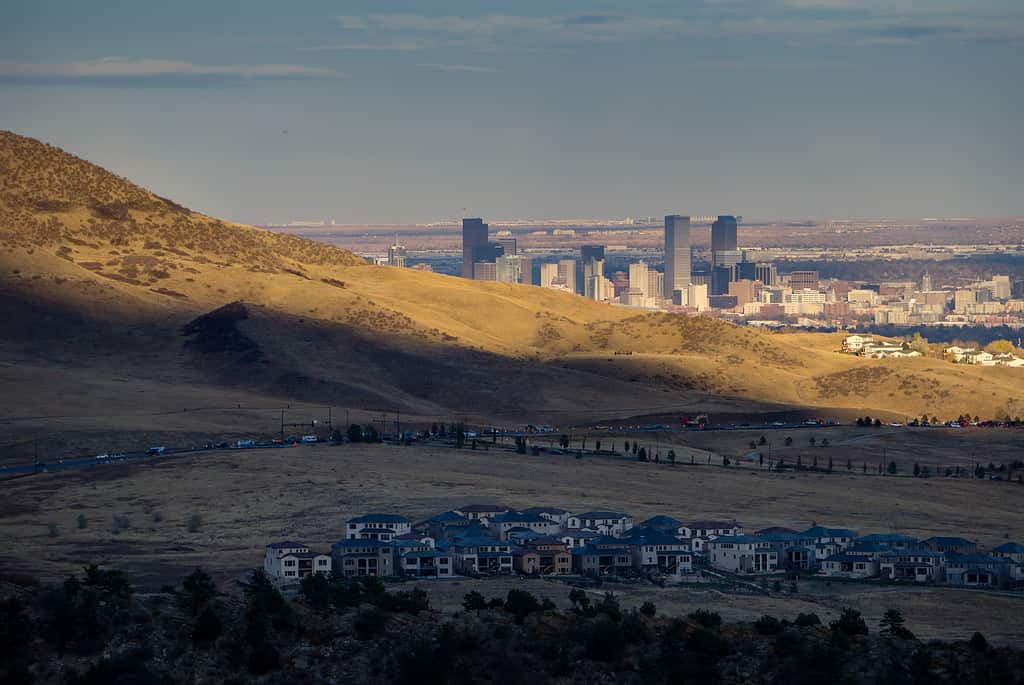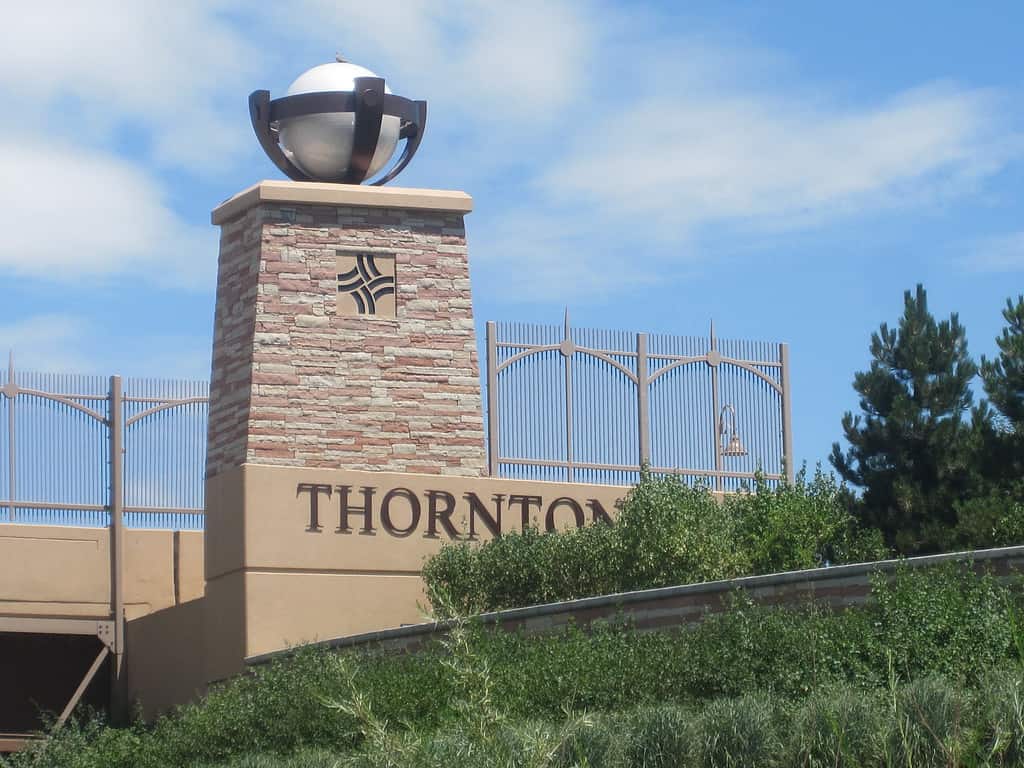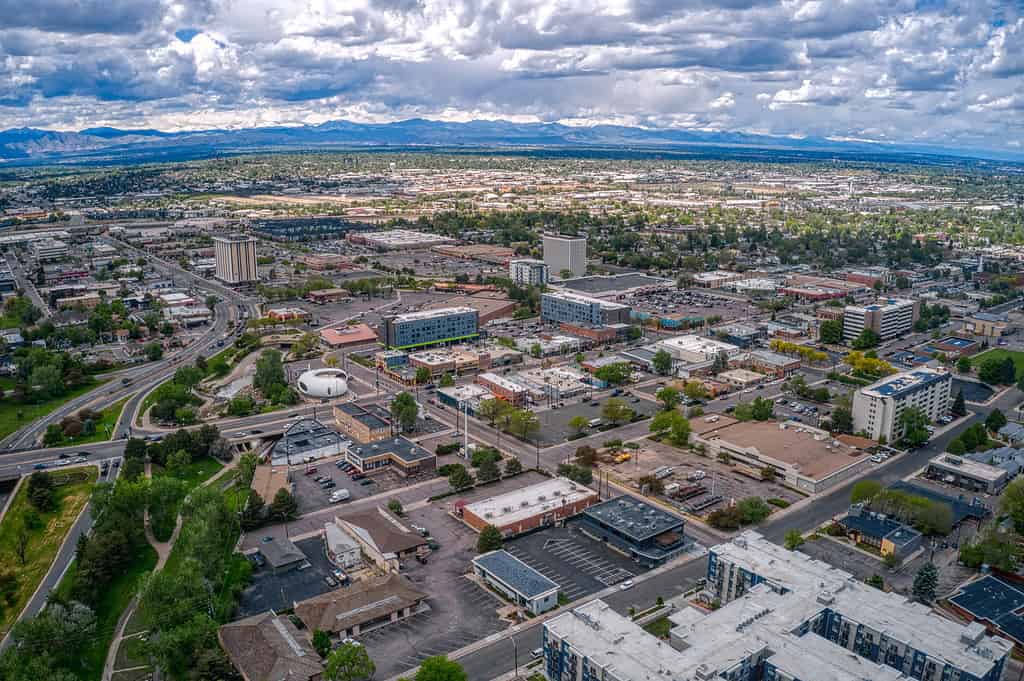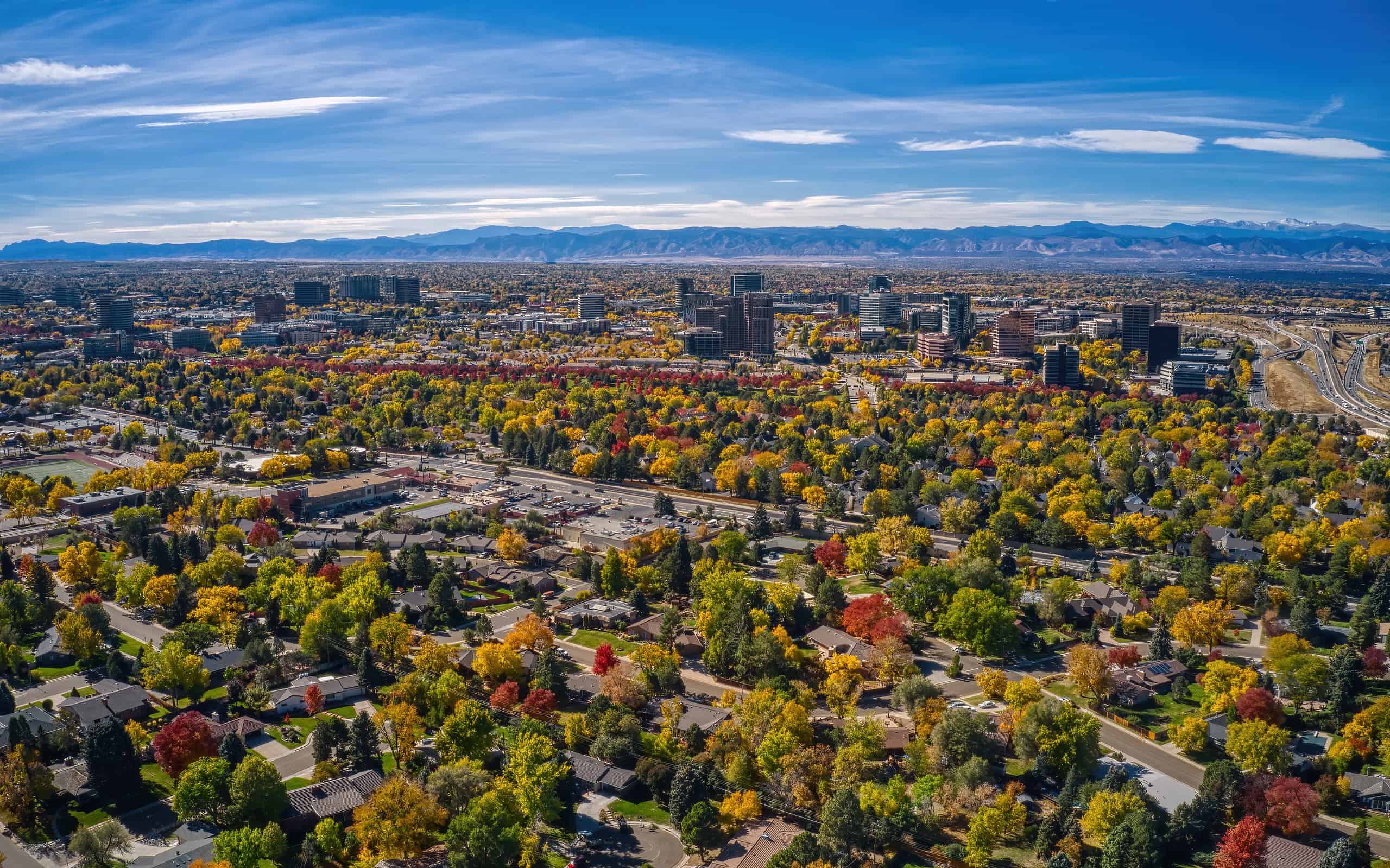Colorado is a state in the Southwest known for its stunning Rocky Mountain landscape, abundant winter sports, and beer culture. It has a varied topography, consisting of alpine mountains, deserts, canyons, and grasslands of the High Plains. Also, it occupies an area of 104,094 square miles, about the size of New Zealand. Colorado is best known for Denver, its capital city. But the state also boasts several other large metropolitans.

Discover the seven largest cities in Colorado by population and total land area and learn about the state’s economy.
The Largest Cities in Colorado by Population
1. Denver

The city of Denver is the largest city in Colorado by population.
©Virrage Images/Shutterstock.com
Denver is the largest city in Colorado by population size, with 713,252 people and an annual growth rate of 1.17%. This metropolis went from a relatively small urban core surrounded by farmland to a booming downtown with skyscrapers and abundant suburban areas. Denver has a land area of 153 square miles and a population density of 4,167 people per square mile.
Located in North-Central Colorado, Denver is located on high-elevated rolling plains just east of the foothills. And it features a semi-arid climate with extremely low humidity and abundant year-round sunshine.
Denver GDP: $214 billion
Top industries: Aerospace, aviation, broadcasting, mining, energy, financial services, information technology, manufacturing, and healthcare
Top employers: Denver International Airport, Comcast, Kaiser Permanente, Lockheed Martin, Centura Health, Dish Network, University of Colorado
2. Colorado Springs

Colorado Springs sits east of the southern Rocky Mountains
©Jacob Boomsma/iStock via Getty Images
With a population of 486,248 and an annual growth rate of 1.17%, Colorado Springs is the second-largest city in Colorado by population. Colorado Springs is within the top ten fastest-growing cities in the state. And it is the largest city in Colorado by land area, covering 194 square miles. It has a population density of 2,140 people per square mile.
Colorado Springs is in Central Colorado, south of Denver. It sits to the east of the Southern Rocky Mountains and is notable for its canyons, mesas, bluffs, grasslands, and mountain creeks. It has an alpine desert climate with a mild year-round forecast, including the winter.
Colorado Springs GDP: $40 billion
Top industries: Medical equipment, aerospace, defense, cybersecurity, advanced manufacturing, finance, and insurance
Top employers: US Air Force, Lockheed Martin, Memorial Hospital, Microchip Technology, Northrop Grumman Corporation, Progressive Insurance
3. Aurora

The city of Aurora is the largest Denver suburb and one of the largest cities in Colorado.
©Jacob Boomsma/iStock via Getty Images
Aurora has a population of 393,537 and an annual growth rate of 0.72%, putting it in third place for the largest city by population in the state. From 2011 to 2021, Aurora grew 17%, faster than most cities around the same size. Aurora is also the second-largest city in Colorado by land area, covering 154 square miles with a population density of 2,412 people per square mile.
Aurora is the largest Denver suburb, overlapping three different counties. The city features many parks, open prairies, and views of the mountains.
Aurora GDP: $214 billion (Denver-Aurora-Lakewood)
Top industries: Educational services, healthcare, social assistance, management, administration, waste management, retail, recreation, food services, and entertainment
Top employers: UC Health, Amazon, Raytheon Intelligence and Space, Kaiser Permanente, Marriott, ADT, Kroger, Staples, Rocky Mountain Regional VA Medical Center
4. Fort Collins

This Northern Colorado city is in the foothills of the Rocky Mountains.
©iStock.com/marekuliasz
Fort Collins has a population of 169,249 and an annual growth rate of -0.29%. While Fort Collins has slightly declined in population since 2022, it grew an average of 1.7% annually between 2010 and 2021. Fort Collins covers 54 square miles of land and has a population density of 2,652 people per square mile.
Located in Northern Colorado, Fort Collins is in the foothills of the Rocky Mountains and along the banks of the Cache la Poudre River. This city has a cold semi-arid climate with warm to hot summers and long, cold winters.
Fort Collins GDP: $20 billion
Top industries: Manufacturing, bioscience, clean energy, beer, software, hardware
Top employers: UC Health, Broadcom, Woodward, Otterbox, Tolmar, Hewlett Packard, Anheuser-Busch, Madwire, New Belgium Brewing Co.
5. Lakewood

Another suburb of Denver, Lakewood is known for its Federal Center, health care, and education jobs.
©Sparty1711/iStock via Getty Images
Lakewood is the fifth-largest city in Colorado by population, with 156,120 people and an annual growth rate of 0.73%. Lakewood’s population has increased by less than one percent since 2020. This city covers an area of 156,120 square miles and has a population density of 3,588 people per square mile.
Lakewood is one of the largest suburbs of Denver, west of downtown and at the base of the Rocky Mountain’s eastern slopes. This city has a climate similar to Denver and Aurora, with cold, snowy winters and hot summers.
Lakewood GDP: $214 billion (Denver-Aurora-Lakewood)
Top industries: Government, education, healthcare, retail, medical device manufacturing, financial services, information technology, and marketing
Top employers: Federal Center, St. Anthony Hospital, Terumo BCT, FirstBank, HomeAdvisor, The Integer Group, Red Rocks Community College, Developmental Disabilities Resource Center
6. Thornton

As a suburb of Denver, Thornton has a similar terrain and climate as the capital and surrounding suburbs.
Thornton has a population of 143,282 and an annual growth rate of 0.31%. Its population increased by 0.94% since the last census in 2020 and has grown over 21% since 2000. Thornton has a land area of 34 square miles and a population density of 3,949 people per square mile.
As a suburb of Denver, Thornton features a topography and climate similar to Denver and the surrounding cities. It is just north of Denver and primarily features flat and undulating hills.
Thornton GDP: Unknown
Top industries: Health care, retail, manufacturing, entertainment, telecommunications
Top employers: Amazon, North Suburban Medical Center, Walmart, King Soopers, Appliance Factory Outlet, Topgolf, Home Depot, Avaya, Rocksol Consulting Group, Murphy Company
7. Arvada

The city of Arvada is known for its parks and green spaces.
©Jacob Boomsma/iStock via Getty Images
Arvada has a population of 121,581 and an annual growth rate of -0.8%. But it experienced a growth rate of 1.6% between 2010 and 2020. Arvada has a land area of 35 square miles and a population density of 3,197 people per square mile.
Arvada is another suburb of Denver known for its many parks and green spaces, and it features rolling grasslands and natural foothills. This city has a similar climate to Denver.
Arvada GDP: Unknown
Top industries: Health care, retail, insurance, manufacturing, social assistance
Top employers: Kaiser Permanente, Target, State Farm, Home Depot, Sundyne, Arvada House
A Comprehensive List of the Largest Cities in Colorado by Population
| Largest Cities in Colorado by Population | Population Size |
|---|---|
| Denver | 713,252 |
| Colorado Springs | 486,248 |
| Aurora | 393,537 |
| Fort Collins | 169,249 |
| Lakewood | 156,120 |
| Thornton | 143,282 |
| Arvada | 121,581 |
| Westminster | 114,533 |
| Pueblo | 111,456 |
| Greeley | 109,209 |
| Centennial | 105,865 |
| Boulder | 105,485 |
| Highlands Ranch | 103,238 |
| Longmont | 98,687 |
| Castle Rock | 80,191 |
| Loveland | 77,884 |
| Broomfield | 76,121 |
| Grand Junction | 68,034 |
| Commerce City | 66,115 |
The Largest Cities in Colorado by Land Area
| Largest Cities in Colorado by Land Area | Land Area |
|---|---|
| Colorado Springs | 194 square miles |
| Aurora | 154 square miles |
| Denver | 153 square miles |
| Black Forest | 100 square miles |
| Pueblo West | 70 square miles |
| Fort Collins | 54 square miles |
| Pueblo | 53 square miles |
| Greeley | 46 square miles |
| Lakewood | 42 square miles |
| Keystone | 40 square miles |
| Grand Junction | 38 square miles |
| Arvada | 35 square miles |
| Thornton | 34 square miles |
| Commerce City | 34 square miles |
| Castle Rock | 33 square miles |
| Loveland | 33 square miles |
| Broomfield | 33 square miles |
| Copper Mountain | 32 square miles |
| Westminster | 31 square miles |
Colorado’s Economic Impact
Colorado has a total population of 5.9 million and an annual growth rate of 0.5% from 2020 to 2022. The state had a gross domestic product (GDP) of $385.83 billion in 2022, growing at an annualized rate of 1.5% over the past five years.
Largest industries by revenue in Colorado: Oil drilling and gas extraction ($37 b), tourism ($26 b), new car dealers ($21 b), hospitals ($21 b), and grocery stores ($16 b).
Top companies by employment in Colorado: Denver International Airport, Walmart, Kroger, Amazon, Lockheed Martin, HCA Healthcare, United States Postal Service, Home Depot, Comcast, and Lumen Technologies.
Top GDP sectors in Colorado: Real estate, professional services, information, manufacturing, healthcare, wholesale trade, finance, retail, construction, mining, and administration.
Summary of the 7 Largest Cities in Colorado
| City | Location | Feature |
|---|---|---|
| Denver | Central Colorado | Capital of Denver; rolling plains and semi-arid climate. |
| Colorado Springs | Central Colorado, 70.5 miles south of Denver | Canyons, mesas, bluffs, grasslands, mountain creeks and alpine desert climate . |
| Aurora | Eastern Denver suburb | Many parks, open prairies, and views of the mountains. |
| Fort Collins | North Colorado, 65.3 miles north of Denver | Rocky Mountain foothills, the Cache la Poudre River and a cold semi-arid climate. |
| Lakewood | Western Denver suburb | At the base of the Rocky Mountains’ eastern slopes. |
| Thornton | Northern Denver suburb | Primarily features flat and undulating hills. |
| Arvada | Northwestern Denver suburb | Many parks, green spaces, rolling grasslands, and natural foothills. |
Thank you for reading! Have some feedback for us? Contact the AZ Animals editorial team.








